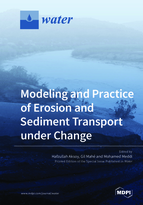Modeling and Practice of Erosion and Sediment Transport under Change
A special issue of Water (ISSN 2073-4441). This special issue belongs to the section "Water Erosion and Sediment Transport".
Deadline for manuscript submissions: closed (31 December 2018) | Viewed by 52314
Special Issue Editors
Interests: hydrology; climatology; solid transport; human impact; environment; hydrological modelling; climatic scenarios
Special Issues, Collections and Topics in MDPI journals
Interests: hydrology; hydrological modelling; water resources; statistical approaches; stochastic modelling; experimental hydraulics; data analysis
Special Issue Information
Dear Colleagues,
Climate and anthropogenic changes impact the conditions of erosion and of sediment transport in rivers. The rainfall variability and, for many places, the increase of rainfall intensity have a direct impact on rainfall erosivity. Increasing demography leads to acceleration of land cover changes in natural areas to cultivated areas, and then sometimes in degraded areas and desertified landscapes. These anthropogenized landscapes are more sensitive to erosion. On the other hand, the increase in the number of dams in watersheds trap a great part of sediment fluxes, which do not reach the sea in the same amount, nor at the same quality, with consequences on coastal geomorphodynamics.
This Special Issue is dedicated to studies of sediment fluxes, from continental areas to coastal areas, observation, modelling and impacts, at different scales, from watershed slopes to the outputs of large river basins.
Dr. Gil Mahe
Prof. Dr. Hafzullah Aksoy
Prof. Dr. Mohamed Meddi
Guest Editors
Manuscript Submission Information
Manuscripts should be submitted online at www.mdpi.com by registering and logging in to this website. Once you are registered, click here to go to the submission form. Manuscripts can be submitted until the deadline. All submissions that pass pre-check are peer-reviewed. Accepted papers will be published continuously in the journal (as soon as accepted) and will be listed together on the special issue website. Research articles, review articles as well as short communications are invited. For planned papers, a title and short abstract (about 100 words) can be sent to the Editorial Office for announcement on this website.
Submitted manuscripts should not have been published previously, nor be under consideration for publication elsewhere (except conference proceedings papers). All manuscripts are thoroughly refereed through a single-blind peer-review process. A guide for authors and other relevant information for submission of manuscripts is available on the Instructions for Authors page. Water is an international peer-reviewed open access semimonthly journal published by MDPI.
Please visit the Instructions for Authors page before submitting a manuscript. The Article Processing Charge (APC) for publication in this open access journal is 2600 CHF (Swiss Francs). Submitted papers should be well formatted and use good English. Authors may use MDPI's English editing service prior to publication or during author revisions.
Keywords
- Hydrology
- Solid transport
- Human impact
- Environment
- Hydrological modelling
- Climatic scenarios
- Sediment transport model
- Experimental research








